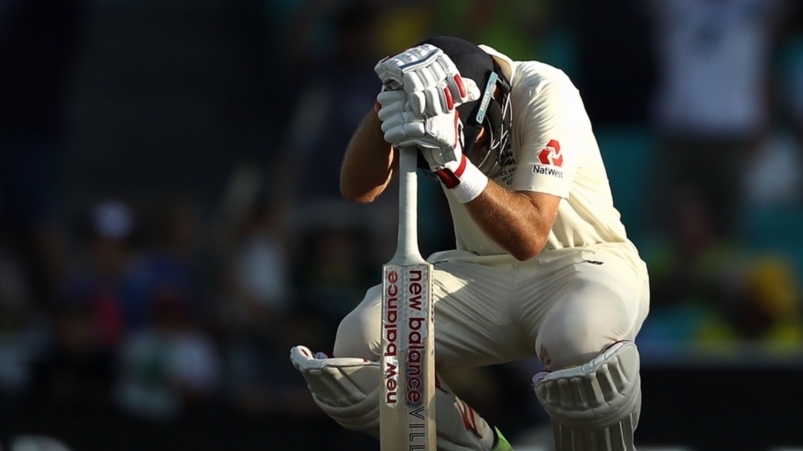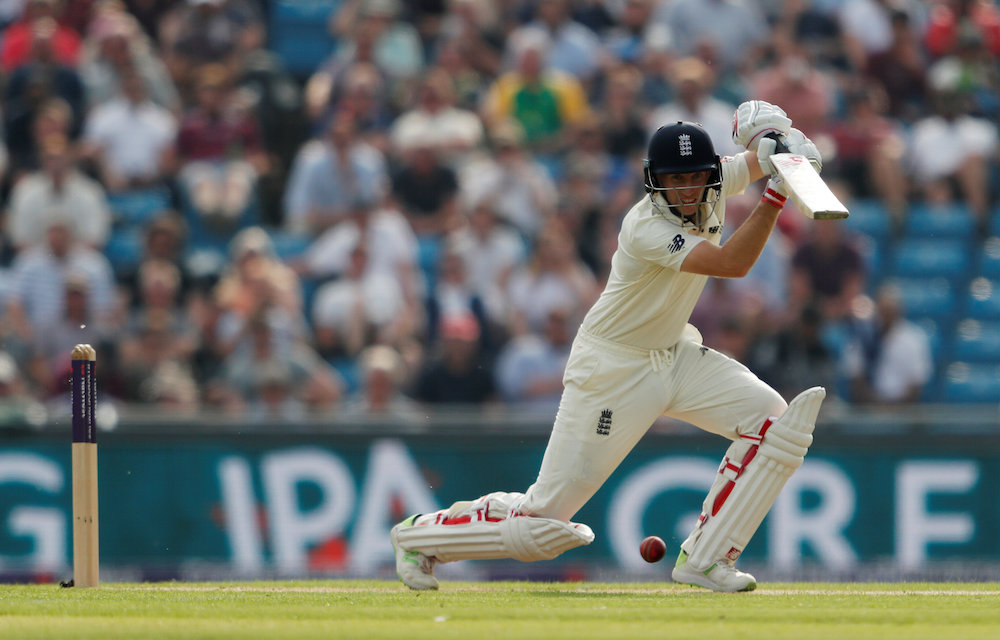Joe Root needs to become more ruthless and prolific with the bat, writes Lawrence Booth in SA Cricket magazine.
At 27, Root’s best years ought still to be ahead of him. But there is a sense in which England fans are growing impatient for him to complete his ascent to greatness.
When Joe Root walks out to bat against India at Edgbaston at the start of August, he will do so knowing his reputation is up for grabs. The prospect will probably enthuse him rather than terrify him, because he is that kind of character. Equally, there are few who dispute he is teetering on the edge of greatness. But the question is: what next? The answer will be central to England’s fortunes over the next five years.
If Root were to retire tomorrow, he would go down as one of his country’s best – but also as a batsman who too often left too many runs in the dressing room. His Test average of 52 is England’s highest since Ken Barrington (58) played his final game in 1968. Yet Root’s conversion rate – he has reached 50 in Tests on 53 occasions, but 100 on only 13 – suggests a curious lack of ruthlessness. And ruthless is the very least a great batsman should be.
Up against Root this English summer will be Virat Kohli, the Indian wunderkind-turned-demigod who regards ruthlessness as an old friend. Because while Kohli has got to 50 only 37 times, he has converted 21 of them into hundreds. Overall, he averages one run more than Root, precisely because he is so hard to dislodge. Once in, he makes the most of it. It’s true that not all English pitches allow a batsman to feel secure, even after his first 20 runs, but the stats say Kohli is pulling clear of his rival. He knows it, and so does Root.
Two other names usually crop up in the debate over the best Test batsman in the world, especially now that AB de Villiers has retired. But one of them, Steve Smith, is in purdah after Australia’s ball-tampering scandal, and the other, Kane Williamson, plays for New Zealand, who haven’t taken part in a Test series of more than three games this side of the new millennium. Williamson appears in dribs and drabs, then vanishes before he can make proper headlines.
So, for the time being, it’s Root vs Kohli – and Root knows he will never have a better chance to get one over his Indian counterpart than in a five-match series in England. On India’s previous tour here in 2014, when England won 3-1, Kohli averaged a miserable 13, fell four times to Jimmy Anderson and lost the whereabouts of his off-stump. A repeat of those travails would help Root’s cause and almost certainly ensure another England victory. But there is more to it than the personal battle. At stake is Root’s legacy – as a batsman and a captain.

Some believe the two are linked, and not necessarily in a good way. They cite Root’s record of only two hundreds (and 13 fifties) since replacing Alastair Cook as England’s Test captain in early 2017. But this is too simplistic a reading. If anything, Root has become more consistent, scoring a half-century virtually every game. Since hitting 136 against West Indies at Edgbaston in August 2017, he has got to 50 in 10 of his 19 Test innings, but eight times has failed to get to 70. So, yes, he’s banker. He’s just not yet a millionaire.
Perhaps the more pertinent question is whether England’s poor recent Test record will begin to weigh him down. When Root sat in front of the media at Headingley on 3 June, it was the first time in almost nine months he had done so as a victorious captain. England’s three-day bulldozing of Pakistan ended a sequence of eight games without a win, not to mention six defeats. It is as if England’s most reliable player – Cook can no longer claim the mantle – needs the buffer of some Test victories before he takes the next step as a batsman.
Root’s appointment as Cook’s successor was considered so inevitable that few paused to wonder what kind of a leader he would make. The wisdom had always been that he possessed a natural cricket brain and would incline towards aggression more than the conservative Cook. But the evidence has so far has raised more questions than answers. Asked during the series against Pakistan what kind of captain he thought Root was, Mike Atherton – one of his predecessors – struggled for an answer.
Root, in other words, had yet to define himself, at least not in a way that made sense to the press and the public.
It is fair to say that not everything he has so far touched has turned to gold. At Headingley a year ago, he sportingly set West Indies 322 in the fourth innings and watched in mounting horror as they eased home by five wickets. Then there was the decision to bowl first in the day-night Ashes Test at Adelaide in December, only for his senior new-ball pairing of Jimmy Anderson and Stuart Broad to waste the advantage by pitching too short. For seasoned England-watchers, it was a familiar problem.

Then, against Pakistan at Lord’s, Root chose to bat in bowler-friendly conditions. England were bundled out for 184, and never recovered. It was the earliest they had lost a home Test: in May at home, they are supposed to be unbeatable. After that game, Root was quizzed about his decision to spend some of his time in the field under the helmet at short leg, but insisted it allowed him a good view of what the batsman was up to. Some, such as Nasser Hussain, another former England captain, thought the move touched the confines of lunacy.
Despite all that, there is no doubt that Root is trying to stamp his mark on the side. After England were skittled for 58 in Auckland in March, he is understood to have lambasted his team for their general approach and fitness levels. It is instructive that Moeen Ali, who has always taken a relaxed approach to gym work, has not played a Test since. After the all-round success of the 20-year-old Somerset off-spinner Dom Bess at Headingley, Ali may struggle to reclaim his spot.
Root’s clarion call for greater physical prowess has long been a favourite of the beleaguered England captain: Graham Gooch and David Gower famously fell out over the matter, one preferring tracksuits, the other opting for sauvignon blanc. But what England fans want to see next is evidence of lateral thought – and, yes, ruthlessness.
Look closely, and there have been one or two hints. Batsman James Vince was dropped for the first Test against Pakistan after a disappointing winter, and Mark Stoneman after the defeat at Lord’s. Neither would have been axed if the captain had fought their corner. In his search for a team capable of beating India, then regaining the Ashes in 2019, Root is clearly prepared to make clear the standards he expects. With that in mind, the success or otherwise of middle-order batsman Dawid Malan against India could be one to follow closely.
Failing any tactical manoeuvres to evoke comparisons with Mike Brearley, Root may decide to take another leaf out of Gooch’s book and lead from the front. With that in mind, his recent decision to move to No 3 – the position coach Trevor Bayliss has long regarded as Root’s natural home – reflects his desire to impose himself on the batting lineup.
In one sense, it is curious the switch has taken so long to become permanent. Back in 2016 against Pakistan, after a year in his preferred slot of No 4, Root accepted the challenge of shunting up a spot, and at Old Trafford scored a sublime 254. A year later, in his first innings as Test captain, he dropped back to No 4, and began with 190 against South Africa at Lord’s. And there, until now, he has stayed.
At 27, Root’s best years ought still to be ahead of him. After all, Gooch scored an incredible 4,563 Test runs after the age of 35 – more than 1,000 clear of the next man on the list, Geoff Boycott. But there is a sense in which England fans are growing impatient for him to complete his ascent to greatness.
He has all the tools, and is second only to Kohli in all-format excellence: Root averages 51 in One-Day Internationals and 39 (with a strike-rate of 128) in T20s. But England need him to make the kind of series-winning contributions that can define a career.
Two recent examples, both against England, set the template. In India in 2016-17, Kohli racked up 655 runs in five Tests at an average of 109. In Australia in 2017-18, Smith managed 687 at 137. In both cases, England lost 4-0. The closest Root has come to matching them is now disappearing into the mists of time: 518 runs at 103 during that win over India in 2014.
It is time for a repeat. If he succeeds, no one will give a damn how much time he spends cowering at short leg.
WORDS: Lawrence Booth, originally published in the July-Sept 2018 issue of SA Cricket magazine.
Photo: Images via Reuters/Lee Smith; Getty Images








